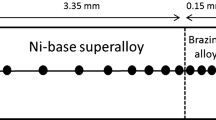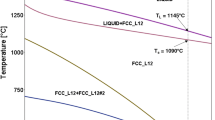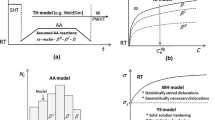Abstract
Although advanced solidification processes like high temperature brazing have gained more and more industrial importance, they still are often not well understood, and defining optimal process conditions for practical use in many cases can be achieved only by expensive experimental trial and error methods. On the other hand, the phase-field method has become more and more powerful for the simulation of solidification and phase transformations in technical alloys. This paper presents phase-field simulations for high temperature brazing of the Ni-base superalloy Mar-M247 using a Si-based AMS4782 filler. The applied phase-field model can be online-coupled to Calphad databases which deliver the thermodynamic and mobility data for this complex multicomponent multiphase alloy. Unknown or uncertain physical parameters like diffusion coefficients have been calibrated by comparing to optical micrographs and EDX element mappings obtained from laboratory braze experiments for the same material combination. By variation of the process conditions the effects of the brazing temperature, the brazing time, and the thickness of the braze gap on precipitation of brittle phases and formation of stray grains as well as changes in the microstructure of the base material itself have been systematically investigated. Results are presented and discussed.
















Similar content being viewed by others
References
W.A. Demo and S.J. Ferrigno: Adv. Mater. Process., 1992, vol. 141, pp.43–5.
D.S. Duvall, W.A. Owczarski and D.F. Paulonis: Weld. J., 1974, vol. 53, pp. 203–14.
W.D. MacDonald and T.W. Eagar: Metall. Mater. Trans. A, 1998, vol. 29, pp. 315–25.
S. Steuer and R.F. Singer: Metall. Mater. Trans. A, 2014, vol 45(8), pp. 3545-53.
A. Ekrami, S. Moeinifar and A.H. Kokabi: Mat. Sci. Eng. A, 2007, vol. 456, pp. 93–8.
S.D. Nelson, S. Liu, S. Kottilingam and J.C. Madeni: Welding in the World, 2014, vol. 58(4), pp. 593-600.
B. Grushko and B. Z. Weiss: Mat. Sci. Eng., 1985, vol. 74, pp. 19-27.
D. Shi, C. Dong, L. Zhang, X. Yang, J. Hou and Y. Liu, Mat. Sci. Eng. A, 2012, vol. 545, pp. 162–7.
AA Wheeler, WJ Boettinger, GB Mc Fadden (1993) Phys. Rev. E 47:1893-909.
S.G. Kim, W.T. Kim and T. Suzuki: Phys. Rev. E, 1999, vol. 60, pp. 7186-97.
J. Eiken, B. Böttger, and I. Steinbach: Phys. Rev. E, 2006, vol. 73, art. id 066122.
MICRESS software, http://www.micress.de. Accessed 30 Jul 2018
B. Böttger, M. Apel, B. Laux, and S. Piegert: Mater. Sci. Eng., 2015, vol. 84, art. id 012031.
B. Böttger, R. Altenfeld, G. Laschet, G. J. Schmitz, B. Stöhr and B. Burbaum: Integr. Mater. Manuf. Innov., 2018, vol. 7, pp. 70-85
Themo-Calc Software, http://www.thermocalc.se. Accessed 30 Jul 2018
B. Böttger, J. Eiken and M. Apel: Comput. Mater. Sci., 2015, vol. 108, p. 283-292.
J. Eiken: Mater. Sci. Eng., 2012, vol. 33, art. id 012105.
A. Carré, B. Böttger and M. Apel: J. Crystal Growth, 2014, vol 380, pp. 5–13.
B. Böttger, J. Eiken and I. Steinbach: Acta Mater., 2006, vol. 54, p. 2697-2704.
Thermotech Ltd., http://www.thermotech.co.uk. Accessed 30 Jul 2018
V. Vaithyanathan, L.Q. Chen: Acta Mater., 2002, vol. 50, pp. 4061–73.
F. Masoumi, M. Jahazi, D. Shahriari and J. Cormier: J. Alloys Compd, 2016,vol. 658, pp. 981-95.
R. Giraud, Z. Hervier, J. Cormier, G. Saint-Martin, F. Hamon, X. Milhet, J. Mendez: Metall. Mater. Trans. A, 2013, vol. 44,pp. 131–46.
Acknowledgment
The authors acknowledge funding by the German Federal Ministry for Economic Affairs and Energy (BMWi) under Grant number 03ET7047.
Author information
Authors and Affiliations
Corresponding author
Additional information
Manuscript submitted October 9, 2018.
Appendix A: Model Parameters and Assumptions for Brazing Simulation
Rights and permissions
About this article
Cite this article
Böttger, B., Apel, M., Daniels, B. et al. Systematic Phase-Field Study on Microstructure Formation During Brazing of Mar-M247 with a Si-Based AMS4782 Filler. Metall Mater Trans A 50, 1732–1747 (2019). https://doi.org/10.1007/s11661-019-05113-3
Received:
Published:
Issue Date:
DOI: https://doi.org/10.1007/s11661-019-05113-3




